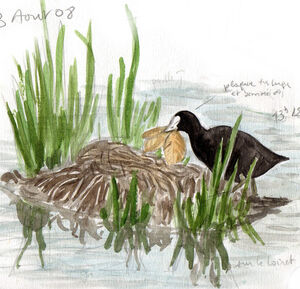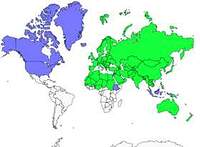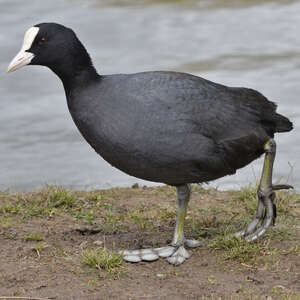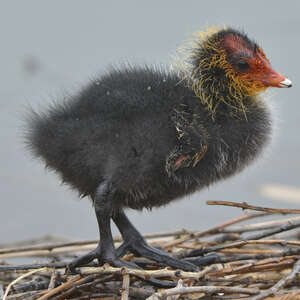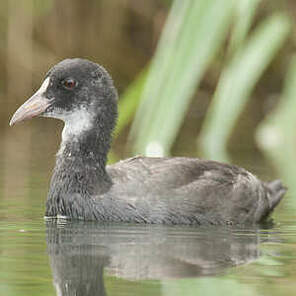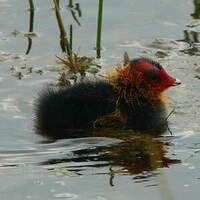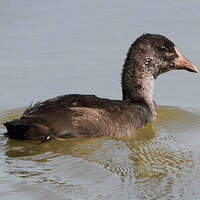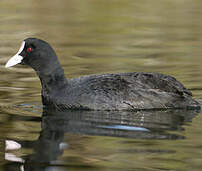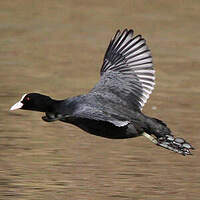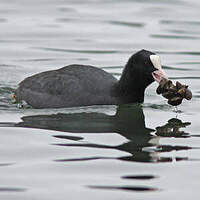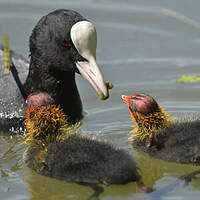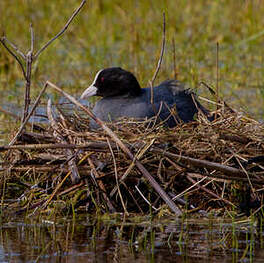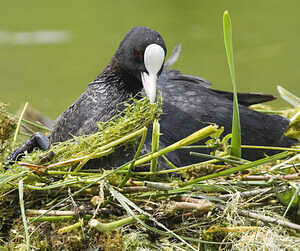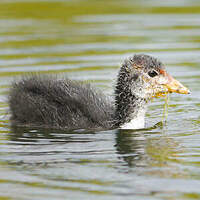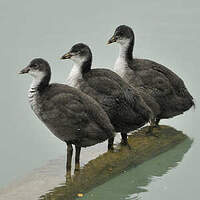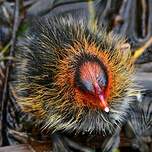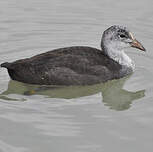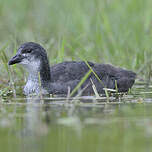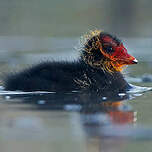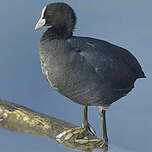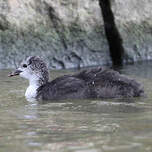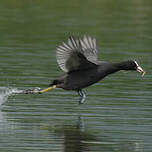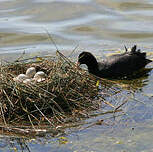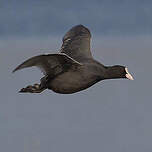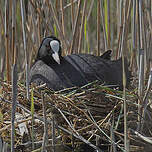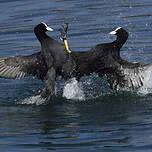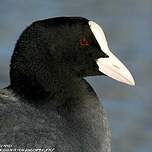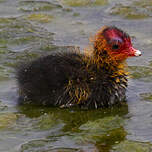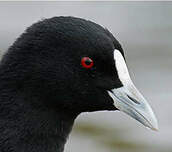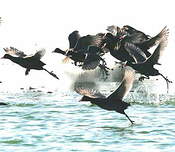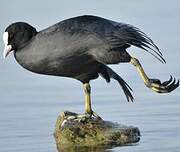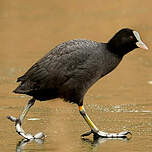Eurasian Coot
Fulica atra - Foulque macroule
Identification
The Eurasian Coot is a large water bird, larger than the Moorhen and less discreet. It has a very dark plumage, grey-anthracite, which can appear black from a distance, and against this black there is a white beak and forehead patch. This white is shaded with pink in the nuptial adult. The body is compact and rounded. The wings are short and rounded and fit the shape of the body. When open, the remiges are pale underneath and on top for the secondaries. The legs are somewhat disproportionate due to their adaptation for swimming. The toes have lobed phalanges which are quite spectacular for swimming. The tarsus and the feet are light grey with yellow stripes and even a bit of orange red on the heel. The chick when hatching is comical. It is covered with black down on the body, but its head is painted with red, orange, yellow and violet. The second down will be grey and the colours of the head will disappear in favour of grey on top and whitish underneath. The juvenile has a bicoloured plumage, medium grey shaded with brown on top and whitish underneath. The beak is yellowish and blackish. From summer, the beak will lighten becoming pinkish while the forehead patch enlarges. The young bird will become adult looking in the course of the autumn.
Subspecific information 4 subspecies
- Fulica atra atra (Europe and n Africa to Japan, India, se Asia, Philippines and Borneo)
- Fulica atra lugubris (Java, Bali, nw New Guinea)
- Fulica atra novaeguineae (nc New Guinea)
- Fulica atra australis (Australia, New Zealand)
Foreign names
- Foulque macroule,
- Focha común,
- galeirão-comum,
- Blässhuhn,
- szárcsa,
- Meerkoet,
- Folaga,
- sothöna,
- Sothøne,
- lyska čierna,
- lyska černá,
- Blishøne,
- nokikana,
- fotja comuna,
- Bleshæna,
- łyska (zwyczajna),
- laucis,
- liska,
- Лысуха,
- Mandar hitam,
- オオバン,
- 骨顶鸡,
- นกคู้ต,
- 白冠雞〔白冠瓣蹼雞,白骨頂〕,
Voice song and call
Discretion is not really the Eurasian Coot's strong suit. It's a rather noisy bird, with a repertoire that's far from musical. It doesn't have a song and its calls are hard notes. It's only among pairs in the springtime that exchanges are more delicate. The most common cry in inter-individual interactions is a distinct tjek or kjek that can turn harsher and more raw with excitement, turning into a kjak or kjrak. Also, there's a sequence of kek kek kek kek.... The alarm call is a loud and repeated pit or pjit. Occasionally, a muffled kjhh like a sneeze can be heard. Juveniles beg for food with a long and insistent uiiiiiiiiiiih. Uniquely, the Eurasian Coot emits multiple pett pett pett...s by hitting its widened fingers on the substrate it resides on. These slightly exploding sounds are highly audible and serve as a cry of sorts, maybe a territorial one. Finally, when flying around during the night, the Eurasian Coot gives off an incredibly characteristic kjen ein ein ein ein or eeinn eeinn ein einnn which stands apart from the kep kep kep of the moorhen.
Habitat
The Eurasian Coot is an aquatic species that occupies all kinds of free continental waters, both natural and artificial, in lowlands and mid-altitude zones during different seasons.
Behaviour character trait
The Eurasian Coot is a gregarious and social bird year-round. For reproduction, it is monogamous and territorial, but in the inter-season, birds are attracted as if by a magnet and can form gatherings of several thousand individuals.
The coot is a rallidae and in this group there are mostly birds that lead a discrete and hidden life like rails and waterhens. The coot takes the opposite approach to these. It is a very visible and vocal bird that does not go unnoticed. Even when alarmed, it remains in sight of danger as it alarms. Of course, in doing this, it attracts predators such as the Osprey or the buzzard but it must think that 'united we stand' to the detriment of the weakest. Diving is a rare ability among rallidae which are usually marsh runners. Coots are an exception and have developed lateral expansions on their feet to enable subaquatic movements after an initial jump to gain momentum.Flight
The Eurasian Coot can only take off by running across the water like a diving duck. Their rapid, jerky and low-amplitude wing beats are however very different from those of ducks. Eurasian Coots are capable of making considerable nocturnal movements, mainly at night, as their direct and slow flight can attract predators such as Peregrine Falcon or Short-toed Snake Eagle.
Dietfeeding habits
During the springtime, the Eurasian Coot is mostly vegetarian. It mostly feeds on submerged plantlife, such as Characées and other higher plants such as potamots, myriophylles, buttercups, and other Polygonacées.
Young coots have the same diet. The plants are collected from the surface or through diving. They also add to their menu insects and their larvae, worms, fish eggs, etc. In the off season, the diet is usually mixed, but with a greater portion of animal matter. For example, they can turn to freshwater bivalve colonies such as Dreissena polymorpha which they access through diving. They can dive down to depths over 2 meters. In the winter it is also very common to see groups of coots grazing in the adjacent meadows of water bodies, and likely consuming both grasses and invertebrates such as oligochate worms.Reproduction nesting
The Eurasian Coot is a monogamous and territorial species, often in conflict with its neighbours as nesting pairs are usually numerous and the contiguous territory.
Depending on altitude and latitude, the breeding period runs from February to September and two subsequent broods are possible. In Europe, the period between March and July is the preferred one. Nesting does not go without conflict as described above. Numerous vocal invectives and assaults allow each couple to fix the limits of its territory. Then they can properly start nesting. The nest is an organized more or less bulky pile of plant organs from the surrounding plants, stalks, leaves, rhizomes, etc. It is built in shallow water in a tuft, in a small tree, on dead vegetation, on a vegetal raft on which it can be floating. Sometimes, it is easily visible to the observers. The inner bowl is lined with linear leaves of monocotylèdons. The female lays six to ten light-beige eggs with a few brown spots. Incubation starts before the end of the laying and takes a little bit more than three weeks. The eggs hatch over several days. The young stay at the nest for a few days before the two parents split them. The female keeps the nest with her half-brood while the male builds a special platform for his. The young feed themselves from the age of four weeks and start to fly at the age of two months. They will gladly stay in the area and may even help their parents take care of the young of the second brood.Geographic range
The Eurasian Coot (Foulque macroule) of the nominal subspecies has a wide range which extends from the Atlantic Ocean to eastern Russia and Sakhalin longitude, both in temperate and tropical latitudes, such as the Indian subcontinent and the Persian-Pakistani region. It also occupies the Canary Islands and Azores. All birds in the northern part of the continent are migratory and winter around the Mediterranean basin, in North Africa to the south of the Sahara and throughout South Asia. There are three other subspecies: lugubris and novaeguineae in New Guinea and australis which occupies Australia, Tasmania and New Zealand, where they are sedentary.
Threats - protection
IUCN conservation status
concern
in the Wild
threatened
evaluated
This species is not globally threatened. It has a wide range and populations count in the millions. However, in Europe, after a period of growth, the trend is on the decline. A figure of -30% in 21 years has been cited. Loss or degradation of habitat is thought to be the cause, as well as hunting in some countries. (info BirdLife International)
Sources of information
- IOC World Bird List (v14.2), Gill, F and D Donsker (Eds). 2024-04-18.
- Guide encyclopédique des oiseaux du Paléarctique occidental, Mark Beaman, Steve Madge
- Rails, Barry Taylor
- Vol. 2 - Handbook of the Birds of the World, Josep del Hoyo-Andrew Elliot--Jordi Sargatal
- Avibase, Lepage Denis
- BirdLife International, BirdLife International
- HBW Alive,
- Wikipedia (English version),
Other sources of interest
 Specification sheet created on
13/07/2023 by Jean François
Specification sheet created on
13/07/2023 by Jean FrançoisTranslation by AI Oiseaux.net
© 1996-2025 Oiseaux.net
- Accipitriformes
- Aegotheliformes
- Anseriformes
- Apodiformes
- Apterygiformes
- Bucerotiformes
- Caprimulgiformes
- Cariamiformes
- Casuariiformes
- Charadriiformes
- Ciconiiformes
- Coliiformes
- Columbiformes
- Coraciiformes
- Cuculiformes
- Eurypygiformes
- Falconiformes
- Galliformes
- Gaviiformes
- Gruiformes
- Leptosomiformes
- Mesitornithiformes
- Musophagiformes
- Nyctibiiformes
- Opisthocomiformes
- Otidiformes
- Passeriformes
- Pelecaniformes
- Phaethontiformes
- Phoenicopteriformes
- Piciformes
- Podargiformes
- Podicipediformes
- Procellariiformes
- Psittaciformes
- Pterocliformes
- Rheiformes
- Sphenisciformes
- Steatornithiformes
- Strigiformes
- Struthioniformes
- Suliformes
- Tinamiformes
- Trogoniformes

